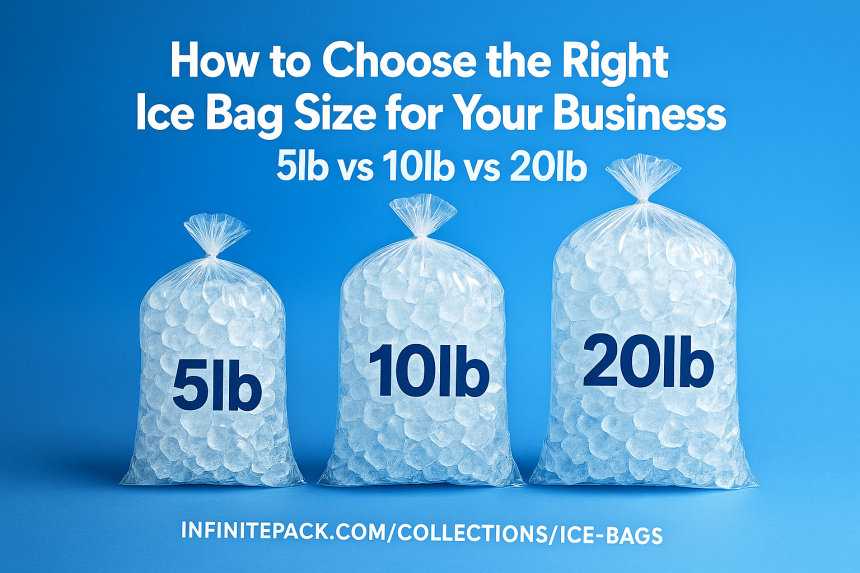In the foodservice and event industries, few supplies seem as ordinary yet essential as ice bags. Whether you’re stocking a restaurant bar, preparing for a catering event, or managing a convenience store, the size of your ice bags has a surprisingly strong impact on efficiency, waste, and storage. Choosing between 5lb, 10lb, and 20lb bags may seem simple at first, but the right choice depends on your operation’s workflow, volume, and handling capacity.
Below, we’ll explore how to evaluate these three common ice bag sizes — and how to match them to the needs of your business.
Why Ice Bag Size Matters More Than You Think
Ice is a perishable product in its own way. It melts, refreezes, and shifts weight with every temperature change or movement. The wrong bag size can lead to unnecessary melt loss, damaged seams, or excessive labor in handling multiple small bags.
A well-chosen size helps streamline your supply chain: fewer refills, fewer bag failures, and easier handling for your staff. Conversely, using an ill-fitted size often means wasted space in storage, higher material costs, or even product loss due to broken packaging.
Beyond volume, the material quality of the bag plays an equally vital role. Most commercial ice bags are made from low-density polyethylene (LDPE), a flexible and durable plastic that maintains strength even in freezing temperatures. Bags made from thinner or inferior materials may become brittle or split when stacked in freezers, leading to leakage and contamination risks.
The 5lb Ice Bag: Lightweight and Convenient
The 5lb ice bag is typically the go-to option for smaller operations or businesses that distribute ice directly to consumers. Convenience stores, food trucks, and small cafes often prefer this size because it’s easy to lift, transport, and sell individually.
This size is also practical for quick-serve applications — such as refilling beverage coolers or storing small amounts of ice behind a bar. The lightweight nature minimizes strain for staff and allows faster rotation of inventory.
However, its convenience comes with trade-offs. If your establishment uses large amounts of ice daily, 5lb bags require more frequent refilling and handling. That means more time spent sealing, stacking, and moving them, which can become inefficient in a high-volume setting.
The 10lb Ice Bag: The Industry Standard
In most commercial settings, the 10lb bag has become the industry standard. It strikes an ideal balance between weight and capacity, making it suitable for a wide variety of businesses — from mid-sized restaurants to hotels and catering companies.
At 10 pounds, the bag is large enough to serve high-volume beverage stations or event setups, yet still compact enough for easy handling by staff. Many suppliers manufacture this size with drawstring or twist-tie closures, which ensure a tight seal and easy portability.
The 10lb size is also easier to organize in storage. It stacks neatly in freezers and coolers without occupying excessive space, reducing the need for multiple storage bins or racks. For most operations, it’s the most efficient “one-size-fits-all” solution.
The 20lb Ice Bag: Bulk Efficiency for Heavy Use
For large-scale users — such as catering services, seafood markets, hotels, or event venues — the 20lb ice bag offers maximum efficiency. With double the capacity of a 10lb bag, it reduces the number of bags that need to be filled, sealed, and moved, which can save considerable time during large events or bulk deliveries.
However, there are a few operational factors to consider. A fully loaded 20lb bag is heavy and can be cumbersome for some staff to carry, especially over long distances or up stairs. It also takes up more freezer space and can be more prone to stress if overfilled.
That’s why many suppliers produce these larger bags with extra-thick plastic (often 1.75 mil or higher) to handle the additional weight and reduce the risk of punctures. Businesses using this size should ensure employees follow proper lifting techniques and that storage areas are designed to accommodate the heavier loads.
Factors to Consider When Choosing Your Ice Bag Size
Choosing between these sizes involves more than just guessing how much ice you’ll use in a day. Consider the following aspects before making a decision:
- Usage Volume:
Estimate your daily or weekly ice consumption. Smaller venues or mobile food vendors may only need 5lb bags, while larger establishments that fill multiple coolers or serve hundreds of guests daily may find 10lb or 20lb more practical. - Handling and Ergonomics:
Employee comfort matters. If your staff frequently carries ice from storage to bar areas or delivery vehicles, lighter bags reduce fatigue and the risk of strain. - Storage Space:
Freezer layout plays a big role. A compact freezer might not easily accommodate bulky 20lb bags. Smaller bags can fit neatly in tighter spaces and allow better rotation. - Filling and Sealing Process:
If you fill your own bags, consider your equipment’s capacity and speed. A bag that’s too large for your ice machine may slow down operations or lead to inconsistent weights. - Customer Expectations (if selling ice):
Retail buyers are often accustomed to 10lb bags for household or recreational use, while smaller 5lb bags may appeal to convenience markets and on-the-go consumers.
Understanding Material Thickness and Durability
In addition to choosing the right size, pay attention to plastic thickness, which determines how much weight a bag can safely hold. Most suppliers rate their bags in mils (thousandths of an inch).
- Around 1.2 mil works for smaller 5lb–8lb bags.
- 1.35 mil is typical for 10lb bags.
- 1.75 mil or more is recommended for 20lb loads.
Thicker bags are less likely to tear or develop leaks, especially when stacked or moved across cold surfaces. For heavy-duty use, look for reinforced seams and drawstring closures, which prevent splitting when the ice shifts during transport.
Making the Final Choice
If your business operates in multiple settings — for example, a restaurant that also caters off-site events — it may make sense to use a combination of bag sizes. Ten-pound bags can serve day-to-day operations, while 20lb bags are reserved for bulk storage or deliveries. Conversely, 5lb bags might be ideal for customer-facing sales or small coolers.
Ultimately, the right size should reduce handling time, minimize waste, and fit naturally into your existing workflow. The decision is part practical, part logistical — but when optimized, it can save both time and money while improving staff efficiency.
The Takeaway
The size of your ice bags may seem like a small operational detail, yet it directly affects efficiency, costs, and convenience.
- 5lb bags work best for smaller, fast-paced environments where portability matters.
- 10lb bags offer the most versatility and fit the majority of business needs.
- 20lb bags are the top choice for bulk users who need to minimize handling time.
Choosing the right balance between these options ensures smoother operations, safer handling, and less waste — small adjustments that can have a measurable impact on your bottom line.





